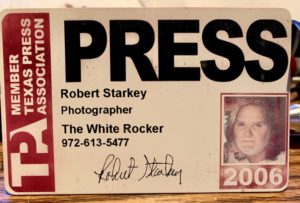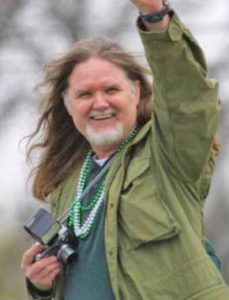By Shari Goldstein Stern
Before cell phones, there were cameras. And photographers. Flashbulbs and negatives. Before Facebook, your photos were your photos. Since Facebook, your photos are up for grabs. And professional photographers are becoming an endangered species. Likewise, before White Rock Lake Weekly there was The White Rocker, circa 1945.

Photos courtesy of Robert Starkey
Robert Starkey, who was born with long hair and a camera around his neck in 1952, was a Bryan Adams ’71 graduate when he became a professional photographer. He described the years 1980 to 2005 as his best. He said, “I miss those 25 years of photography for The White Rocker.”
He went to work in 1980 for the late Retta Hanie, 1927 – 2013, then The White Rocker’s editor and owner. In that role, the photographer captured the White Rock community at its best and worst. Mostly best. “Retta paid me $15 for a photo when she used it. By 2000, I got $30 per picture,” he said.
As a pro for the weekly community newspaper, which morphed into White Rock Lake Weekly in 2009, his favorite assignments were Friday night football games. “I regularly covered Bryan Adams (BA), Woodrow Wilson, Lake Highlands, Bishop Lynch and Skyline. I would see a few plays at one game, then rush off to another,” he said.
“I put a lot of mileage on Retta’s 1974 Dodge Omni between Forrester Field and the other stadiums. The white car had The White Rocker News painted on the side in blue, which was fun driving to Lubbock for one of the play-off games.”
Another favorite job was the Woodrow Wilson High School’s 75th reunion, where he caught photos of many well-known Dallasites and Woodrow alumni, including Carroll Shelby, who invented the Ford Shelby Mustang; actor, commercial spokesman and all-around-good-guy Burton Gilliam; Barbara Adamson, the Texas Care Van program manager; Mary Brinegar, president of the Dallas Arboretum and Botanical Garden; and a host of other Woodrow Wilson Hall of Famers.
When he covered all the Cotton Bowl games each year, the paper had a press box, and Retta obtained press packets for TWR staff to attend many of the related dinners and events.
Starkey set up a darkroom in his kitchen and spent eight to 10 hours on Wednesday nights printing pictures to turn in Thursday mornings. “Once Retta finally bought a computer and started doing layouts, stories and photos digitally, I got Photoshop and what had taken me eight to 10 hours only took me eight to 10 minutes,” he reported. Then he quipped: “Retta Hanie meets technology! Wasn’t sure I’d ever see that day!”
According to the roving photojournalist, Casa View, Casa Linda, Lake Highlands and Lochwood were his usual beats, but he spent hours just wandering around the lake and taking photos for Retta to use when she needed filler images. From the Bath House to Winfrey Point, the Boat House to Dreyfuss Club, the spillway to the filter building, sailboats to the Dallas skyline across the lake, and right up to H.L. Hunt’s southern plantation on the north shore, he was proud to revere the historic spots around Dallas’ gem, White Rock Lake.
Like most other native White Rockers, Starkey grew up with a subscription to The White Rocker in his home. He attended Reinhardt Elementary School, Gaston Jr. High and Bryan Adams. He started taking pictures early, and at Gaston he always had a camera hanging around his neck.
He still gets emotional when he talks about a heartbreaking experience a few years ago. All his photos and negatives — work, including The White Rocker, personal and family treasures were in one box. Somehow the box was mixed up with others that were thrown out. It put him into a tailspin for some time, which apparently hasn’t passed. He was glad to learn this week that the Downtown Dallas Public Library houses The White Rocker archives, and he plans a long excursion — or a few — downtown.

Prior to working for The White Rocker, Starkey was working for The Dallas Times Herald during a lengthy printers’ strike. For his $1.75 minimum wage, he found himself inking presses and taking customer complaints aplenty. His wage grew slightly when he took over a district manager’s desk. He was drafted into the army in 1972, where his job was with the military police. After two years in the service, he returned to the Herald where he maintained his job and full benefits intact. “That was the law then, and I found it generous,” he commented. Then he received his full education, including in photography, from three Dallas County Community District Colleges covered by the GI Bill. He was photo editor for Dallas Homes Magazine for 10 years.
Today, the retiree struggles with neuropathy in both feet, a condition typically resulting from diabetes. He is living the quiet life in Yantis, near Sulphur Springs in East Texas with his buddy George, a recent widower, along with his Pug and three rescues.
Starkey wrapped up with a flashy: “I worked for Retta from 1980 until 2005. I sure miss my White Rocker days as photographer. Best 25 years ever!”
